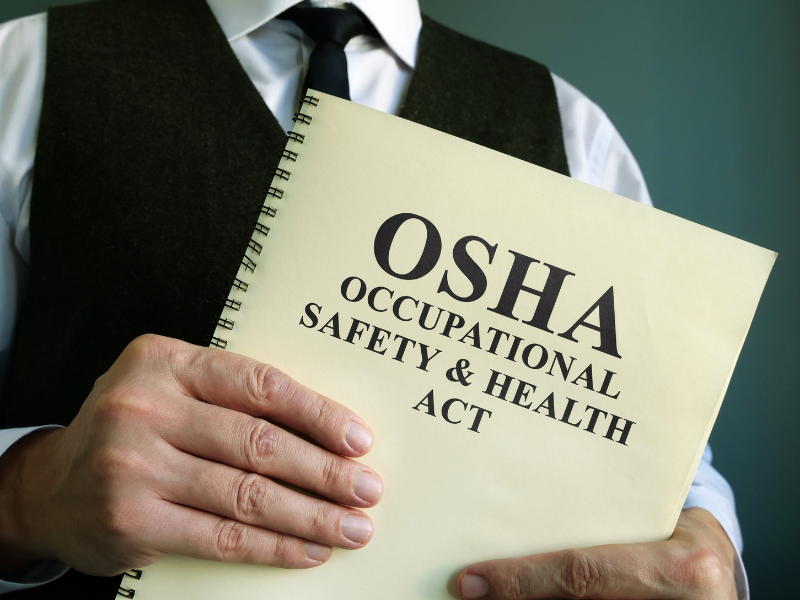The Occupational Safety and Health Administration (OSHA) enacted a vaccine mandate for the U.S. workforce during the COVID-19 pandemic.
Here’s a handy guide for employers about the COVID-19 OSHA vaccine mandate.
Table of Contents

What Is the OSHA Vaccine Mandate?
The OSHA vaccine mandate is the COVID-19 Vaccination and Testing Emergency Temporary Standard (ETS) released by OSHA in the United States on November 5, 2021. It aims to guide employers of 100 or more employees in mitigating and preventing the spread of the COVID-19 virus in workplaces. The ETS required employers to obligate employees to get vaccinated or wear a face mask and undergo regular testing.
What Is the Role of OSHA in the Vaccine Mandate?
The Occupational Safety and Health Administration (OSHA) is a regulatory agency established in 1970 under the U.S. Department of Labor. Its primary mission is to ensure employees across all U.S. industries have safe and healthy working conditions.
To accomplish its mission, OSHA enforces workplace safety and health standards, provides training, conducts outreach activities, and offers assistance to employers and workers. During the COVID-19 pandemic, OSHA provided the vaccine mandate as guidance for employers to protect their workers and keep workplaces safe from the hazards of the virus.

Key Points of the OSHA Vaccine Mandate
- Vaccination policy – Employers must have a mandatory COVID-19 vaccination policy, except for employers that allow employees to choose vaccination, weekly testings, or wearing face coverings.
- Employee vaccination status – Employers need to know and document the vaccination status of each employee.
- Support for vaccination – Employees get paid time for vaccination, up to four hours for the primary dose. Paid time off is provided for recovery from vaccine side effects.
- Testing for unvaccinated employees – Unvaccinated employees are tested weekly (if working on-site) or before returning to work (if absent for a week or more).
- Positive test or diagnosis – Employers must promptly notify if they test positive for COVID-19. Infected employees are removed from the workplace until they meet return-to-work criteria.
- Employee information – Provide employees with clear information about the mandate, workplace policies, vaccine benefits, and protections against retaliation or discrimination.
- Reporting – Report work-related COVID-19 fatalities to OSHA within 8 hours and in-patient hospitalizations within 24 hours.
- Record accessibility – Allow employees or their representatives access to relevant records. Employers must also keep records of employee vaccination status and make those records accessible to employees or their representatives upon request.
Who Does the OSHA Vaccine Mandate Apply To?
The vaccine mandate by OSHA applies to large employers or companies with 100 or more employees. According to Husch Blackwell, the employee count includes part-time and seasonal employees and excludes independent contractors. The mandate affects around 84 million private-sector workers.
All in all, the following groups of workers are affected by this mandate:
- Unvaccinated workers
- Workers with incomplete vaccination
- At-risk workers, such as those who are immunocompromised
- Fully vaccinated workers located in high-transmission areas
Exemptions For OSHA Covid-19 Vaccine Mandate
According to OSHA’s COVID-19 Vaccination and Testing ETS, the vaccine mandate doesn’t apply to the following entities:
- Workplaces covered under the Safer Federal Workforce Task Force COVID-19 Workplace
- Safety: Guidance for Federal Contractors and subcontractors
- Settings where any employee provides healthcare services or healthcare support services when subject to the requirements of the Healthcare ETS (§ 1910.502)
- Workplaces of employers who have fewer than 100 employees in total
- Public employers in states without State Plans
Employees of covered employers may also not be covered by the mandate if they:
- Do not report to a workplace where other employees are present
- Work from home
- Work exclusively outdoors

Can Workers Refuse Vaccination?
Employers can allow workers to refuse vaccination only if they submit to COVID-19 testing. If workers opt for testing, they should also wear masks at work.
Who Pays for COVID-19 Tests?
New York Times OSHA Vaccine Mandate FAQs say that employers are not required to pay for tests since the vaccine is free. However, employers may be required to pay under collective bargaining agreements or local laws.
When Did The Vaccine Mandate by OSHA Take Effect, and When Did It End?
The COVID-19 OSHA vaccine mandate was issued on November 15, 2021. Initially, affected employers were given until January 10, 2022, to comply with most provisions and until February 9, 2022, to comply with the testing requirement.
However, NPR reports that the Supreme Court blocked the mandate on January 14, 2022, after it was determined that the OSHA exceeded its authority. On January 25, 2022, OSHA released a statement on the status of the OSHA COVID-19 vaccination and testing ETS, withdrawing the ETS as an enforceable ETS. Despite this, the federal agency didn’t withdraw the ETS as a proposed rule and continued to strongly encourage vaccination against COVID-19.







